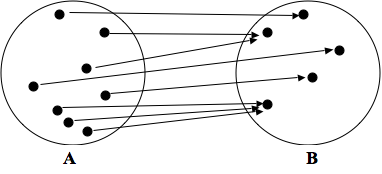Function, as understood in mathematics, is a procedure, a rule, assigning to any object a from the domain of the function a unique object b, the value of the function at a. A function, therefore, represents a special type of relation, a relation where every object a, from the domain is related to precisely one object in the range, namely, to the value of the function at a.
Definition. A binary relation F is called a function (or mapping, correspondence) if aFb1 and aFb2 imply b1 = b2 for any a, b1, and b2. In other words, a binary relation F is a function if and only if for every a from dom F there is exactly one b such that aFb. This unique b is called the value of F at a and is denoted by F(a) or Fa. [F(a) is not defined if a Ï dom F.]
English translation: A function is a rule that connects members of the domain to members of the range such that for every member of the domain there is a unique member of the range it hits: if you know the point at which you start, you know where you end up.

The picture above represents a function from A to B. Is it OK that two or more points in A go to the same point in B? Yes. Because if you know the starting point in A you know the ending point in B. Would it be OK if the arrows from some of the points in A were connected to more than one point in B? No! Because then knowing the starting point in A wouldn’t definitely tell you where you’d end up in B!
p |
~p |
T |
F |
F |
T |
x |
f(x) |
1 |
2 |
2 |
3 |
3 |
4 |
4 |
5 |
The connectives of propositional logic express truth functions. They take you from truth values to truth values, in particular, from the truth values of the sentences they “connect” to the truth value of the whole that’s put together by them. They’re functions in the very same sense that functions in math are. The difference is that the “points” you’re interested in math are numbers whereas the “points” that interest us are truth values. The truth table for each of the connectives defines the function it expresses in just the way that you might define a mathematical function (on a finite domain) by writing out a table showing what values it has for different numbers. Compare, for example the table for f(x) = x+1 for numbers 1 to 4 and the truth table for ~ : The notation is a little different, and we’re dealing with truth values rather than numerical values, but it’s the same old thing!